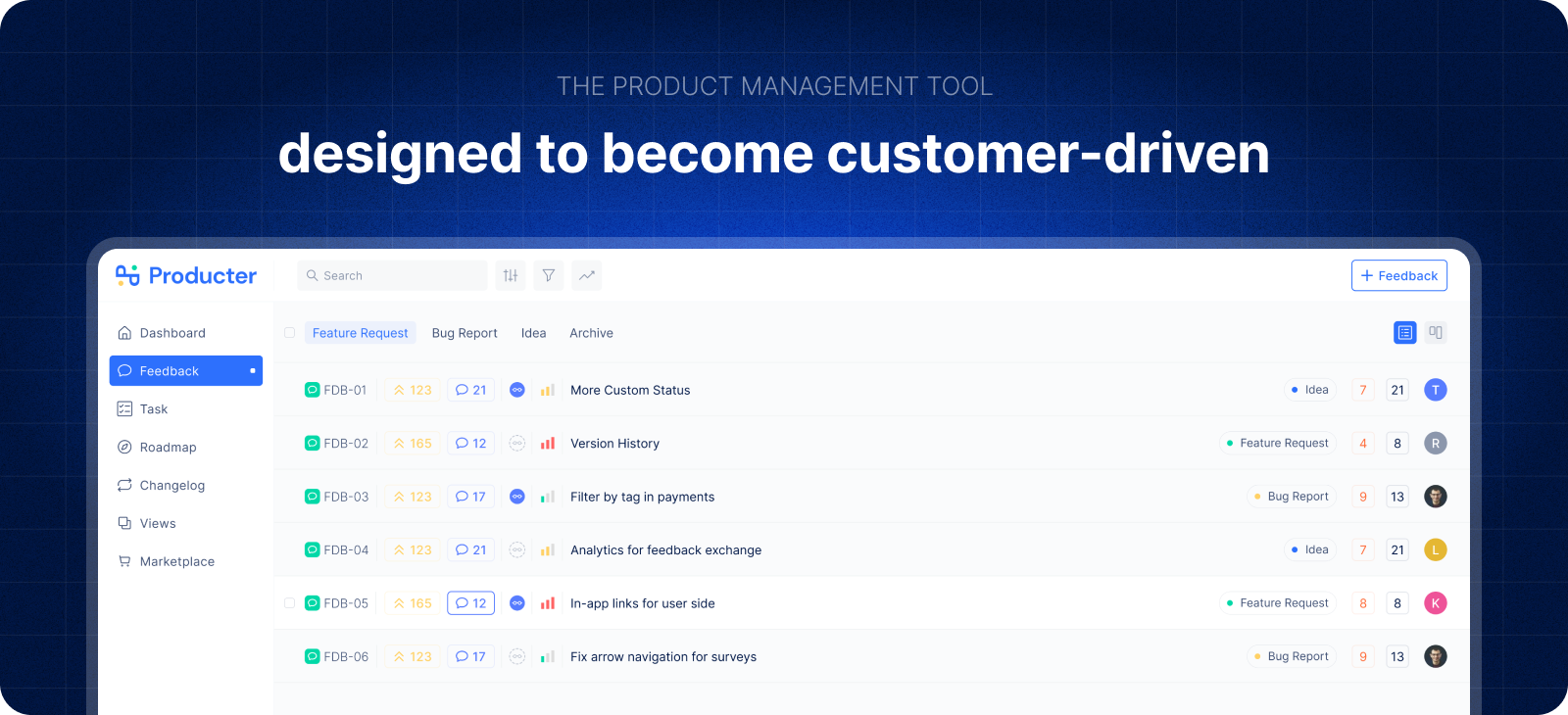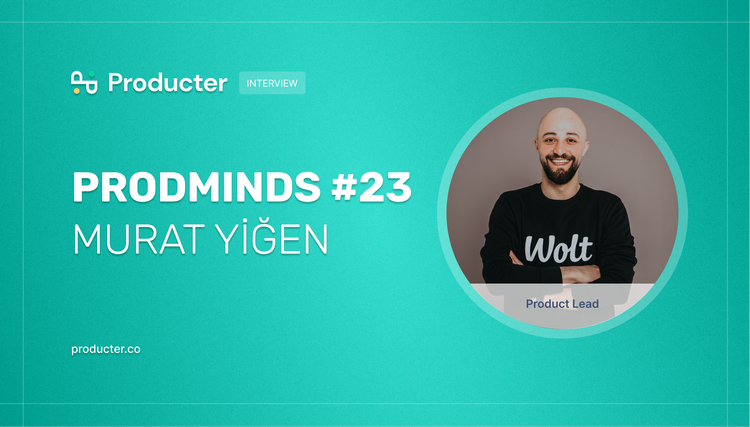Product Operations is a discipline that facilitates and increases the productivity of the product team by making product management and development processes easier. It coordinates the functional, technical, and operational elements of product management, enabling the product team to work more efficiently.
By providing support on topics such as data analysis, reporting, business processes, and project management to the product team, Product Operations increases the success of the product. Therefore, Product Operations plays a vital role in the success of any product management team.
We contacted Aybala to learn more about Product Operations from someone with more experience. Have a pleasant read!
Team Producter: Would you tell us a bit about you and your career path in product operations?
Aybala: Hi, I am a Product Operations Leader and Career Mentor. Along the way, I’ve had the pleasure to work with companies of various industries and sizes both in Berlin and Istanbul such as Siemens Healthineers, Inveon, Garanti BBVA, idealo, Delivery Hero and commercetools.
With my background in Mathematics and Design Thinking I love bringing analytical thinking and human centricity together. Having started my career in Sales, with the passion to solve user problems, I transitioned into Product Management over the years.
I have always been a natural collaborator, communicator and facilitator by heart who is passionate about enabling and empowering product teams to create high impact outcomes, the best possible experience for the users, and operate effectively by improving the way the product is developed and communicated. So although it hasn’t always been called the way it is today, I’ve been informally doing Product and Operations for the majority of my career and I’ve been truly enjoying my journey.
Team Producter: Which part of being a Product Ops is the most challenging for you?
Aybala: Product Operations is a super dynamic, rewarding and fun role as we discover and tackle various different challenges spanning a variety of super interesting topics and collaborate with lots of amazing people from many different areas that spark learning and creativity. In the end with the little things we do to enable internal teams, we create great value for all the users which I always find super empowering. Even if that’s mostly the case, of course, it is not all sunshine, rainbows and unicorns. I think one of the things we need to be careful of is how we manage ad hoc and more pressing requests in a reactive way (a.k.a firefighting) and balancing it with strategic, proactive and long term thinking. Especially when you first set up Product Operations, there are too many things that have been waiting to be operationalized, improved or centrally-owned. For this, it is crucial to constantly communicate what Product Operations means within the context of your company, how it creates value together with transparently sharing how you prioritize your Product Operations topics and initiatives, just as you would do in your product work. This way, you would ensure that everyone better understands the why behind those focus areas, why some other topics are not tackled (just yet!) and that everyone is aligned on them.
Team Producter: Can you describe your process for conducting user research, and how do you use that information to inform product decisions?
Aybala: Currently in our organization, user research is something that Product Managers drive together with their UX Design partners. As Product Operations, we rather focus on “How can we enable our product teams to conduct better user research by providing access to right user groups, insights and data?” together with “How can we support them in structuring the way they synthesize and communicate their findings?”.
And there is data and insights everywhere all at once: feedback coming from users, analytics data, user interviews, usability tests, beta programs, win/loss analysis and many more depending on your context.
In the end, we use all these to identify opportunities, validate hypotheses, prioritize them and inform our strategic roadmaps to turn them into actions and measure their success.
Team Producter: How do Product Management and Product Operations collaborate to ensure the success of a product?
Aybala: We are one team with one shared goal: creating impactful products and best possible experiences with maximum value. We collaborate closely to achieve that and how this collaboration looks like changes from organization to organization based on the size and needs.
On the road to success, Product Operations and Product Management are partners in crime, so it is very important that we have a close relationship and effective communication in between, so that both understand each other’s priorities and challenges. It is especially important for Product Operations to understand the needs of product teams and its collaborators to address real problems, act as a trusted advisor and enabler and create value in the end. For this we leverage 1:1s with the product team, conduct listening tours and regular health checks together with forming working groups around specific topics (product strategy and roadmapping working group, tool champions etc.) to co-create solutions.
Product Operations is mostly about managing change and co-creation is the key here to do that right. By involving different people and perspectives, we work together closely on certain topics by defining our goal as a group, aligning on how we work together, gather needs and feedback, come up with solutions, roll it out to our teams and iterate on them. This increases our chances of success and adoption by fostering a sense of trust, engagement and value creation.
Team Producter: How do you work with cross-functional teams, such as engineering, design, and marketing, to ensure that everyone is aligned on the product vision and goals?
Aybala: Bringing a great product to the market is definitely a team sport and we are stronger as we collaborate and align more. Even if we do great product discovery and unlock user needs and opportunities, we can not develop it without engineers, design it without designers or bring it to the market without Go to Market teams. And this all works out if we are aligned on the vision, strategy and goals, and if everyone understands the why behind product decisions.
It is easier to ensure that everyone is aligned on the product vision and goals when you are a small and intimate team (e.g. 3-4 product teams and a handful of Go to Market people). At this scale, everyone is able to just ping one another, jump on calls quite easily and so on. Alignment gets more challenging as the organizations grow and the communication channels don’t scale at the same rate. The increased adoption of remote and decentralized work practices add an additional layer of complexity to this challenge, so we need to streamline the way we align as the number of people we need to collaborate with increases enormously. As Product Operations, we bring everyone together around the product vision and goals by:
- Operationalizing the way we communicate and collaborate with cross functional stakeholders and involving the right people early on in the product development process. Product Trio (a group consisting of product manager, designer and engineer working tightly together) is a great starting point to achieve this. The best is to use this concept as a baseline and then extend it based on the roles you have within your company and your specific needs to make sure that the right people are involved in the right decisions. For example, you might want to add Product Marketing, Documentation or your Partner Marketing sparring partners to that group.
- Increasing strategic alignment to make sure we all contribute to our company vision and that everyone understands the why behind product decisions. Amazon 6-pager like documents and strategy briefs are great tools for that. Using them as an inspiration and defining what kind of information you need to include in there, creating your own template and communication plan is a great approach to achieve that. Communicating the roadmaps transparently. As now we are aligned on the vision and goals, it’s time to align on how we’ll get there. It is important to share those plans with your sparring partners so that they know when to create that marketing campaign, engage with other tech partners or start upselling the new shiny thing you are creating. The key is to transparently share your roadmaps and giving a space for people to clarify the questions they might have. You can leverage your product roadmapping tooling to create that alignment efficiently and in a self service way and support that with more interactive presentations, video recordings and designated QA sessions when needed.
Producter is a product management tool designed to become customer-driven.
It helps you collect feedback, manage tasks, sharing product updates, creating product docs, and tracking roadmap.






